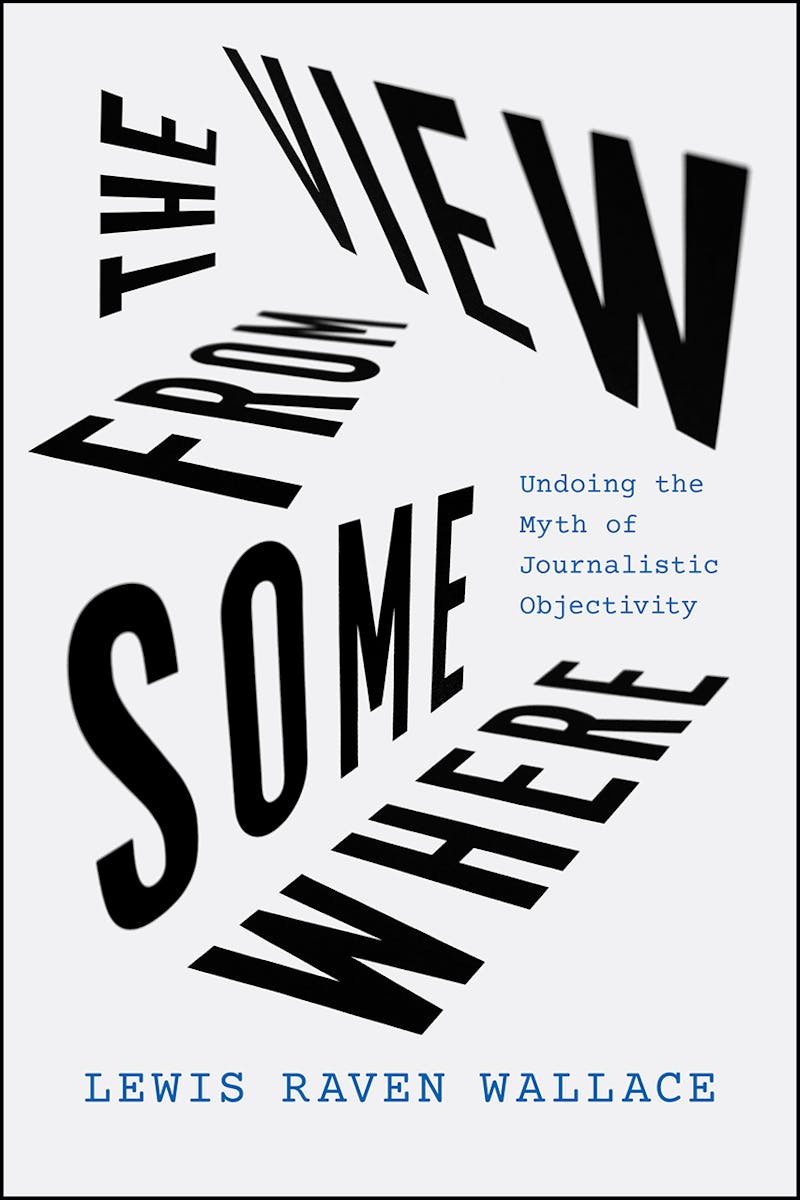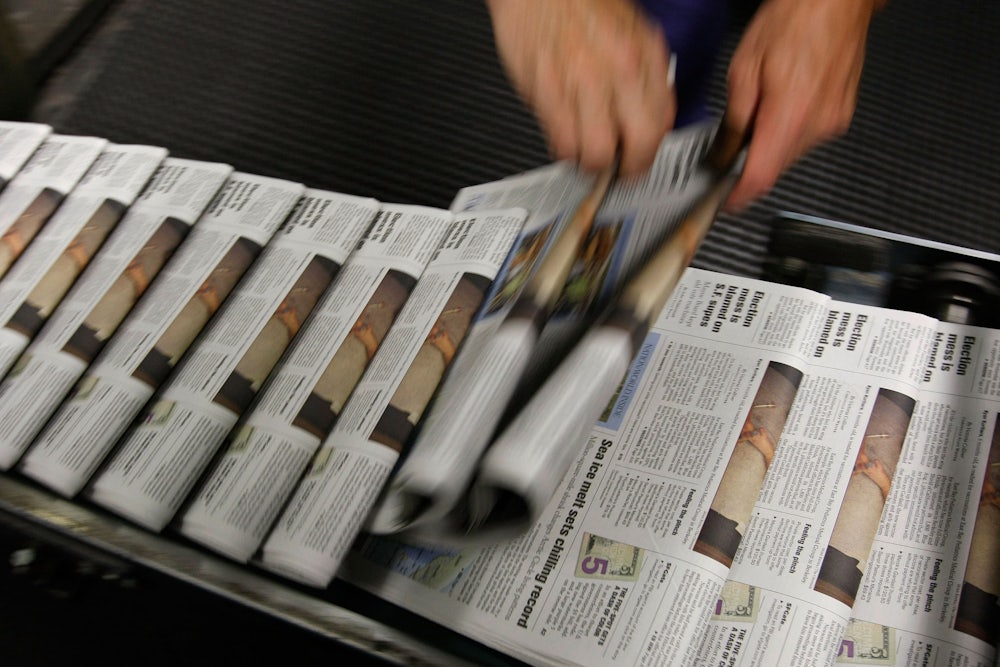In January 2017, Kellyanne Conway, at that time President Trump’s press secretary, coined the term “alternative facts” on Meet the Press. The term was part of a broader move by President Trump and others on the right to discredit journalists, taunting them as “enemies of people” and purveyors of “fake news.” In this environment, the mainstream press doubled down on its commitments to truth-telling and objectivity. The Washington Post introduced the new slogan, “Democracy Dies in the Darkness.” The New York Times aired a pompous ad during the Oscars titled “The Truth is Hard.” The nonprofit ProPublica used the motto “Defend the Facts” in its fundraising. Newsrooms were defending the twentieth-century ideal of impartial journalism, leaning hard on its norms and brand.

What a commitment to objectivity meant, however, was often the appearance of fairness. Neutrality meant showing two sides to every story, even in cases where one side’s arguments were much weaker than the other’s. Over the summer, The New York Times looked into conditions at a Staten Island Amazon warehouse and told the story in a way that was more than generous to management. More recently, the paper was criticized by this magazine for taking its both-sides-style reporting on impeachment so far as to take right-wing conspiracy theories at face value. “Objectivity” also meant veering away from describing figures on the right in unflattering terms—avoiding the words “lies” or “racism”—because those descriptions could be seen as evidence of left-wing bias. Above all, it meant that reporters themselves could not be seen to have any political opinions, because then they would be vulnerable to accusations of impropriety, regardless of the accuracy of what they actually wrote.
Just days after the new president was sworn in, NPR’s senior vice president of News, Michael Oreskes, defended his organization’s choice not to call the president elect’s fabrications “lies.” On that same day, January 25, 2017, the popular public radio show Marketplace fired an award-winning transgender journalist, Lewis Raven Wallace, after he wrote a blog post questioning journalistic objectivity. In a follow-up post describing the firing, Wallace notes that the ethics code he was accused of having violated didn’t contain the words “objectivity” or “neutrality.” The show hadn’t received blowback for this transgression (or any of Wallace’s work), nor had he advocated for any particular political position. He merely offered skepticism about the frame, suggesting that as a trans journalist, he could not be impartial about attacks on his humanity. During his firing, Marketplace Vice President Deborah Clark told Wallace about leaving the anti-apartheid struggle—choosing journalism over activism—as a student: The subtext was that Wallace had to get in line. He didn’t, and paid the price with his job.
Wallace follows in a long line of journalists who questioned the sacrosanct wisdom of objectivity. His new book, The View From Somewhere: Undoing the Myth of Journalistic Objectivity, aims to place his own story in the context of a long history of deviants and agitators who resisted the basic premise that media should be neutral. The ideal of neutrality, he shows, has been used both by the center to marginalize radical voices and by the right as a bludgeon to quiet and discredit its critics. Meanwhile, right-wing media organizations do not hold themselves to the same standard—Fox News’s infamous slogan “Fair and Balanced” came at the expense of liberals who took it at face value. One Weekly Standard writer has described the right’s strategy as: “Criticize other people for not being objective. Be as subjective as you want. It’s a great little racket.” As long as the left tries to be fair to the right, but the right does not try to be fair to the left, objectivity will always push discourse to the right.
The ideal of objectivity is relatively recent. Before the 1830s, newspapers and pamphlets were mostly produced either by political parties (appealing to men who could vote) or business interests, which created trade journals; and, before advertising took hold, early American newspapers were in some cases subsidized by the government. It was, by most accounts, the advent of the penny press—newspapers with mass appeal—that pioneered the advertising business model and led more directly to the papers we know today.
Tracing these changes, journalism scholar David Mindich has identified a shift in the mid-nineteenth century from partisan political writing to the more detached, observational writing that foreshadows modern journalistic conventions. This included formats that separated fact-based writing from editorial essays, and the birth of the professional reporter, who went out to gather the news not as a political participant but as a neutral observer.
Between the late 1880s and World War I, the newspaper business was “unsure of its place” and went through many changes to establish the norms newspapers employ now. In was in these years that the first professional journalism schools opened and ethical standards for the profession started to be established. Mindich argues that objectivity, at least as an ideal, began to form in the 1890s, directly alongside the professionalization of the trade, shifting from a “low-class occupation” to a specialized one.
By 1924, a book called The Ethics of Journalism by Nelson Antrim Crawford spelled out these standards: a wall between advertising and editorial, a moratorium on bribes, fact-checking and thorough sourcing, and a greater reliance on “experts.” The historical moment in which this occurred was in the wake of World War I, when the nation got a taste of mass propaganda created by the U.S. government to support the war effort. In his book Public Opinion, The New Republic’s founding co-editor Walter Lippman lamented the role of naked distortions in shaping public perceptions. Within two years of Lippman’s book’s publication in 1922, rigorous standards began to take form. Some were skeptical—“Show me a man who thinks he’s objective, and I’ll show you a man who’s deceiving himself,” Henry Luce, the founder of Time, said in 1923—but a consensus was hardening.
Although Wallace says that objectivity “emerged for many of the right reasons,” he argues that it was just as quickly “weaponized,” as it was ideologically used to police journalism’s bounds. With the rise of objectivity and professional ethics, Wallace writes that the “gates went up,” leaving many outside. The first journalist to be fired for a breach of objectivity (not unlike Wallace) was Morris Watson, a reporter from the Associated Press in 1935. What made him “biased,” according to his bosses, was his effort to organize a union with the Newspaper Guild. He sued, and the newly formed National Labor Relations Board took his case and brought it to the Supreme Court, which ruled in his favor. The AP had not found any actual bias in his reporting, the court found, but was banking on “potential bias” to thwart his organizing.
Watson was a victim of what Wallace dubs “journalism’s purity ritual,” which can be described as using objectivity as a pretext to fire someone for their politics. One particularly egregious example Wallace came across was a 1996 headline in The New York Times: “Gay Reporter Wants to Be Activist.” As the paper of record reported:
To labor leaders … Sandy Nelson is an unlikely hero—a lesbian, socialist journalist. But to the top editors at The [Tacoma] News Tribune, where Ms. Nelson works, she is a walking conflict of interest whose off-duty activities threaten the credibility of journalism.
During the 1980s, Nelson was involved in a local struggle to pass a human rights ordinance that would prohibit job discrimination against gay workers. Although political expression was allowed by her union, Nelson was relegated to the copy desk by her editor, a post from which she filed a lawsuit. Unlike in Watson’s case, the Washington State Supreme Court ruled against her, deciding that journalists were exempt from a state law protecting employees from retaliation for political expression. When Wallace interviewed Nelson for the book, she told him, “They didn’t go after people who were involved with their churches, or people who were in the Boy Scouts. They can be political, can’t they?” She believed her bosses intended to make an example out of her, adding, “During the McCarthy era they went after people in the same way.”
The tendency to exclude gay journalists, on the grounds of “objectivity,” from conversations about issues that affected the gay community led to serious problems in media coverage. In 1982, as the AIDS death toll continued to rise to around 400, The New York Times ran only five stories; none were on the front page. For comparison, the paper ran four front page and 50 total articles on the Tylenol scare that year, which killed seven people. Yet executives there refused to allow those close to the crisis to influence the paper’s reporting. Instead, as one critic charged in 1981, “Lesbians and gay men at the Times were allowed little—if any—positive influence over the paper’s coverage of gay people.” As Wallace shows, the Times was criticized repeatedly for its homophobic stories, often qualifying crimes with the word “homosexual” (as in “homosexual murder”), prompting journalists and activists to pressure the paper to stop using the term. The Times never reported on violence against queer people but would go out of its way to say if the perpetrator of a crime was gay.
The ideal of objectivity has led to an increase in “both-sidesism”—often elaborate attempts to avoid showing favor to any person in a story. One of the most telling examples of this was The New York Times’s coverage of the killing of Michael Brown by a white police officer in Ferguson, Missouri, in 2014. In its coverage, the Times went out of its way to portray “balance.” In a story about Brown’s memorial, the paper remarked that he was “no angel” and went out on a limb to mention that he allegedly stole an iPod when he was in ninth grade, a fact that had nothing to do with his death. The memorial piece concerned itself with trafficking heavy-handed moral obfuscations. At one point, it quoted a violent lyric (“My favorite part is when the bodies hit the ground”) in a rap song Brown had “collaborated on,” as if that could somehow be morally comparable to the police violence that saw his body fall in the same manner.
Instead of objectivity or impartiality, The View From Somewhere advocates for a different distinction: between earnestly searching for the truth and peddling distortions and falsehoods. For Wallace, it’s OK for journalists to admit where they are coming from, while still “hanging on to some basic tenets of traditional journalism ethics: verification and fact-checking, editorial independence from political parties and corporations, clarity and transparency about financial and political conflicts of interests, and deep, thorough sourcing.” In Wallace’s paradigm, “curiosity” is the “antidote to misinformation and disinformation.”
Wallace calls for more collaborative journalism, like Chicago’s City Bureau or Indigenous Media Rising, where members of communities work with journalists to change what kinds of stories are covered and how. Still, in-depth, curious journalism is difficult and expensive to produce, and many newsrooms are strapped for resources, if they even exist at all. Today, some 1,400 communities have lost papers in the past 15 years (it is within these vacuums that Trump excelled), more papers are owned by indifferent hedge funds, and even civic-minded philanthropy seems to overlook local news. The economic precariousness of the news business remains outside of Wallace’s purview. Democracy has been dying in the darkness for quite some time. What The View From Somewhere makes dazzlingly clear is that saving journalism will mean saving it from a false notion of objectivity.
